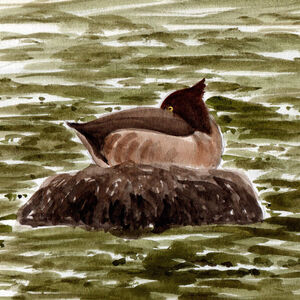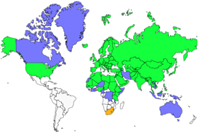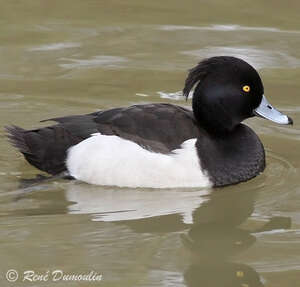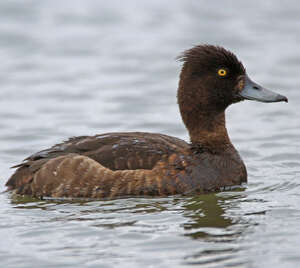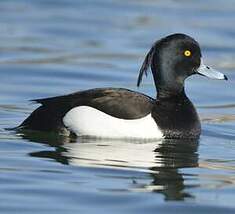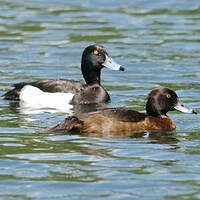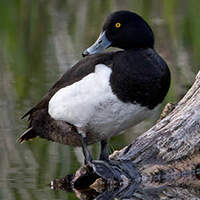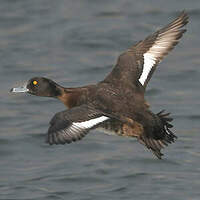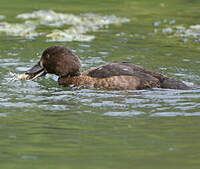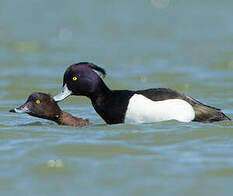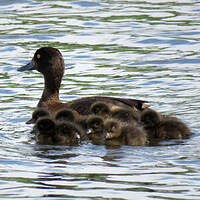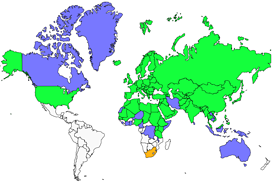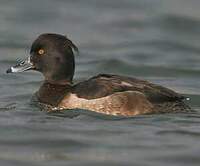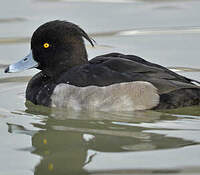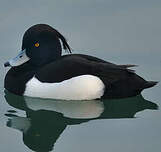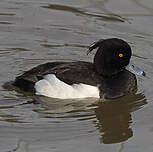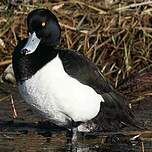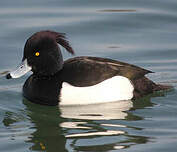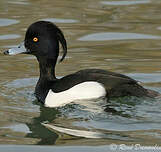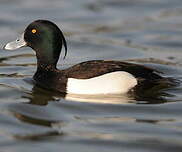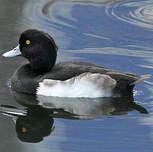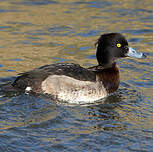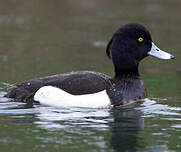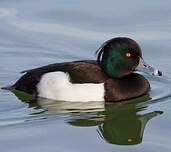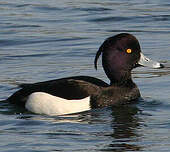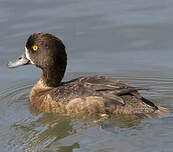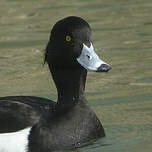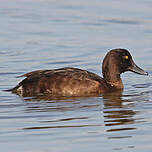Tufted Duck
Aythya fuligula - Fuligule morillon
Identification
The Tufted Duck is an Old World diving duck that is easily identifiable, as there is a distinct sexual dimorphism in its nuptial plumage. The adult male is bicolored; when perched on the water they appear uniformly black, with white flanks and a nape that falls over their neck. When in flight they appear black on top and white underneath. The white wing bars, formed from the white bases of its primaries, stand out well against the black background. On closer inspection, the belly, flanks, and the undersides of its wings are all white, in contrast to the front and back which are black. In good light, its head often gives off a slight green or purple sheen. Its eyes are yellow, its beak blue with a black tip and indistinct white ring. Its legs are gray.
In eclipse plumage, after breeding season, the flanks turn to a dark brown hue that lighten again as winter sets in. At the same time, the second year males have less distinct blacks, with browner flanks, a less prominent tuft, a more grayish beak, and a dull yellow eye.
The adult female has a much darker brown in place of the male's black, with lighter brown flanks that often appear streaked, in contrast to the blander hue of the rest of the bird. The tuft is shorter and less prominent. The beak is slightly less blue, and the eye is still yellow. In flight, it bears the same white wing bars on top, and its underside is pallid, except for its flanks. In its non-breeding plumage, there is not much change. Often there will be a pale patch on the side of its face at the base of its beak, which may be confusing with a female of the Common Goldeneye, but the tufted head should prevent confusion. The undertail coverts often appear pale, and could be mistaken for a Ferruginous Duck, especially when the flanks are warm brown.Once again, the shape of the head brings the reality. The young female of the second year is distinguished from her elder by her widely grey beak and her less yellow eye. The chick is remarkable with her dark grey down feathers, unmistakable in our country. The juvenile in the end of summer has a female plumage. Its beak is grey and its eye is honey.
Subspecific information monotypic species
Foreign names
- Fuligule morillon,
- Porrón moñudo,
- zarro-negrinha,
- Reiherente,
- kontyos réce,
- Kuifeend,
- Moretta,
- vigg,
- Toppand,
- chochlačka vrkočatá,
- polák chocholačka,
- Troldand,
- tukkasotka,
- Kuifkopeend,
- morell de plomall,
- Skúfönd,
- czernica,
- cekulpīle,
- čopasta črnica,
- Хохлатая чернеть,
- Kambangan hitam,
- キンクロハジロ,
- 凤头潜鸭,
- เป็ดเปีย,
- 鳳頭潛鴨,
Voice song and cries
Habitat
The Tufted Duck is associated with fresh, flowing and still waters of a certain depth. For reproduction, it looks for in fairly large water bodies, with a medium depth (3-5 m), with terrestrial and aquatic shore vegetation. In winter, its choices can widen to encompass expanded and calm sections of rivers, reservoirs, recreational bodies of water and among littoral waters, estuaries and brackish lagoons.
Behaviour character trait
This Tufted Duck finds its food under the surface. Its immersion usually lasts 10 to 20 seconds. Propelled by its large webbed feet, it can go down as deep as 7 meters.
It is sociable, even in breeding season: its nest is often close to that of seagulls and terns. Its sociability is especially expressed in winter, when hundreds or even thousands of Tufted Ducks gather on the best wintering sites in spectacular groups.
Dietfeeding habits
The diet of the Tufted Duck is mixed. It is both vegetarian, especially during the warm season, feeding on aquatic plants (leaves, fruits, and Seeds), and also a predator in all seasons. It especially likes mollusks, both bivalves and gastropods in both fresh and salt water, beginning with the edible marine mussel Mytilus edulis. In fresh water, the zebra mussel, an invasive species, is also prey. It also includes aquatic insects and their larvae, as well as crustaceans such as crayfish.
Reproduction nesting
The Tufted Duck is monogamous. Couples form at the end of winter or the beginning of spring. There is no set rule, some birds pair off before migrating, others do it upon arriving at their nesting grounds.
They stay together for the season, but since there is proven loyalty to the nesting site, the same partners can reunite and re-pair the following year. The adults parade in loud groups, with frequent head movements and ritualized preening.There is only one clutch per year and nesting is late. It begins in May. The nest is a small platform of grass and reeds lined with down located near the water, on the ground in herbaceous vegetation. In May-June, the female lays 8 to 11 eggs in an incubation period of 23 to 28 days. She cares for the eggs alone and covers them with insulating down when she leaves the nest. The ducklings, covered in gray-black down, are precocial and quickly leave the nest. Flight occurs at the age of 40-45 days. The young Tufted Duck can reach sexual maturity at one year old, but it usually happens at two.
Geographic range
The Tufted Duck has a wide distribution throughout the eurasian continent. It breeds in Iceland and the British isles, and from the tip of Brittany to Kamchatka, Russia in a continuous band of temperate and boreal latitudes.
The wintering area is disjoint, and located much farther south, except for the British isles and western Europe which also host many wintering individuals. The wintering area also includes southern Europe, the Mediterranean coastline, the Black and Caspian Seas, Southwest Asia, India, the countries bordering the Bay of Bengal, the Chinese Sea, the Korean Peninsula, and the Japanese archipelago.
Some long-distance migrants reach the Sub-Saharan Africa (Senegal, Ethiopia, etc).
Threats - protection
Sources of information
- IOC World Bird List (v14.1), Gill, F and D Donsker (Eds). 2024-04-18.
- Canards, cygnes et oies d'Europe, d'Asie et d'Amérique du Nord, Reeber Sébastien
- Ducks, Geese and Swans, Kear, J
- Wildfowl: An identification guide to the ducks geese and swans of the world, Madge, S and Burn, H
- Avibase, Lepage Denis
- Birds of the World, The Cornell Lab of Ornithology
- xeno-canto, Sharing bird sounds from around the world,
Other sources of interest
 Specification sheet created on
23/07/2023 by Jean François
Specification sheet created on
23/07/2023 by Jean FrançoisTranslation by AI Oiseaux.net
published: 19-12-2020 - Updated: 19-12-2020
© 1996-2024 Oiseaux.net
- Accipitriformes
- Aegotheliformes
- Anseriformes
- Apodiformes
- Apterygiformes
- Bucerotiformes
- Caprimulgiformes
- Cariamiformes
- Casuariiformes
- Charadriiformes
- Ciconiiformes
- Coliiformes
- Columbiformes
- Coraciiformes
- Cuculiformes
- Eurypygiformes
- Falconiformes
- Galliformes
- Gaviiformes
- Gruiformes
- Leptosomiformes
- Mesitornithiformes
- Musophagiformes
- Nyctibiiformes
- Opisthocomiformes
- Otidiformes
- Passeriformes
- Pelecaniformes
- Phaethontiformes
- Phoenicopteriformes
- Piciformes
- Podargiformes
- Podicipediformes
- Procellariiformes
- Psittaciformes
- Pterocliformes
- Rheiformes
- Sphenisciformes
- Steatornithiformes
- Strigiformes
- Struthioniformes
- Suliformes
- Tinamiformes
- Trogoniformes

